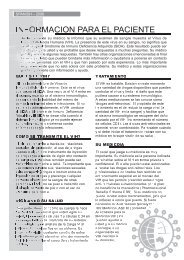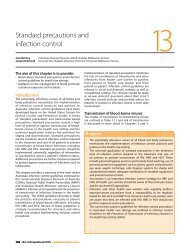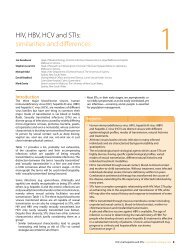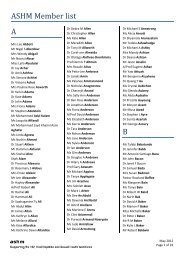B Positive – all you wanted to know about - ASHM
B Positive – all you wanted to know about - ASHM
B Positive – all you wanted to know about - ASHM
Create successful ePaper yourself
Turn your PDF publications into a flip-book with our unique Google optimized e-Paper software.
12 Privacy, confidentiality and other legal responsibilities<br />
� Security and s<strong>to</strong>rage of health<br />
information<br />
a range of laws apply <strong>to</strong> the s<strong>to</strong>rage of health<br />
information. Health agencies should have in<br />
place:<br />
� Procedures <strong>to</strong> give access <strong>to</strong> information<br />
only <strong>to</strong> those people who are authorised <strong>to</strong><br />
have access in order <strong>to</strong> use or disclose the<br />
information<br />
� security measures <strong>to</strong> prevent unauthorised<br />
access <strong>to</strong> the records<br />
� Procedures for s<strong>to</strong>ring the information,<br />
where practical, in a way that the identity<br />
of the person is not readily apparent from<br />
the face of the record, e.g. by the use of<br />
identification codes<br />
� Procedures for destroying the records that<br />
protect the privacy of the information.<br />
electronic records pose new ch<strong>all</strong>enges. While<br />
they offer greater convenience of data retrieval<br />
and transfer, electronic record systems also<br />
create greater risks of data leakage, access<br />
by unauthorised staff and ‘browsing’ by<br />
unauthorised people. agencies and businesses,<br />
including medical practices need <strong>to</strong> consider<br />
the security of their data s<strong>to</strong>rage and transfer<br />
systems and the problem of staff intention<strong>all</strong>y<br />
or inadvertently accessing prohibited electronic<br />
records. this issue is currently being addressed<br />
by the commonwealth and a number of states<br />
in the development of their electronic health<br />
records systems, and has proven enormously<br />
complex <strong>to</strong> date.<br />
� Information for teams<br />
Multidisciplinary treating teams are common<br />
practice in australian health care. Health<br />
care practitioners work <strong>to</strong>gether and share<br />
necessary information <strong>to</strong> deliver optimum<br />
health care. <strong>all</strong> transfers of information without<br />
the <strong>know</strong>ledge of the patient require careful<br />
ethical consideration.<br />
although the question has not yet been leg<strong>all</strong>y<br />
tested, private sec<strong>to</strong>r health service providers<br />
do not always require a patient’s consent <strong>to</strong><br />
disclose specific health information <strong>to</strong> another<br />
member of a multidisciplinary team for a health<br />
care purpose, as long as the patient would<br />
reasonably expect that disclosure. therefore, it<br />
is advisable <strong>to</strong> tell a patient being treated by a<br />
94 b <strong>Positive</strong> <strong>–</strong> <strong>all</strong> <strong>you</strong> <strong>wanted</strong> <strong>to</strong> <strong>know</strong> <strong>about</strong> hepatitis b: a guide for primary care providers<br />
multidisciplinary team how this will affect the<br />
handling of their health information. it is also<br />
advisable <strong>to</strong> gain patient consent <strong>to</strong> avoid<br />
relying on implied consent. other limited<br />
exceptions under nPP 2 permit disclosure<br />
without consent in certain circumstances,<br />
including <strong>to</strong> lessen a serious and imminent<br />
threat <strong>to</strong> an individual’s life, health or safety; or<br />
where the disclosure is required or authorised<br />
by law.<br />
there is a need for doc<strong>to</strong>rs in group practices<br />
<strong>to</strong> formulate clear internal communication<br />
pro<strong>to</strong>cols in order <strong>to</strong> exercise reasonable care,<br />
for example, when communicating test results<br />
or considering contact tracing issues. the<br />
cross-referencing of files per se will gener<strong>all</strong>y<br />
not breach statu<strong>to</strong>ry confidentiality because<br />
results need <strong>to</strong> be checked, though information<br />
should not be disclosed without explicit<br />
permission. it is vital that <strong>all</strong> staff are aware of<br />
their obligations and that systems are in place<br />
for protecting patient privacy.<br />
Exemptions <strong>to</strong> privacy and<br />
confidentiality obligations<br />
the use and disclosure of health information<br />
is defined in the Privacy act under nPP 2<br />
(available at http://www.privacy.gov.au/<br />
publications/npps01.html#npp2), which states<br />
that an organisation must not use or disclose<br />
personal information <strong>about</strong> an individual for<br />
a purpose other than the primary purpose of<br />
collection, except for a number of situations,<br />
including where an organisation reasonably<br />
believes that the use or disclosure is necessary<br />
<strong>to</strong> lessen or prevent a serious and imminent<br />
threat <strong>to</strong> a person’s life, health or safety, or a<br />
serious threat <strong>to</strong> public health or public safety.<br />
in short, health care workers must not disclose<br />
a person’s health information except in a very<br />
limited number of circumstances. these may<br />
gener<strong>all</strong>y be summarised as:<br />
� communicating necessary information <strong>to</strong><br />
others directly involved in the treatment of a<br />
patient during a particular episode of care<br />
� cases of needlestick injury where a<br />
professional is aware of a patient’s HbV<br />
positive status, and a health care worker<br />
has been exposed <strong>to</strong> circumstances where<br />
there is a real risk of transmission and it is






